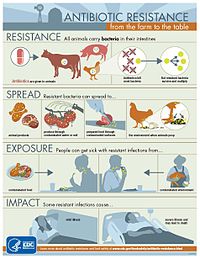
Photo from wikipedia
Antimicrobial resistance in non-typhoidal Salmonella is a critical problem globally, with the emergence of resistance to third-generation cephalosporins (3GCs) a particular concern. The aim of this study was to use… Click to show full abstract
Antimicrobial resistance in non-typhoidal Salmonella is a critical problem globally, with the emergence of resistance to third-generation cephalosporins (3GCs) a particular concern. The aim of this study was to use whole-genome sequencing (WGS) to characterise recently identified human and non-human isolates of 3GC-resistant Salmonella enterica subsp. enterica serovar Typhimurium from Australia. The Illumina NextSeq sequencing platform was used to determine the genome sequences of 78 S. Typhimurium definitive type 44 isolated in Australia between 1992 and 2016, including 31 3GC-resistant isolates. Phylogenetic and bioinformatics analyses were subsequently performed using a number of in silico tools. We report the emergence of 3GC resistance in locally-acquired Australian S. Typhimurium for the first time. Phenotypically resistant isolates of human and animal origin were geographically restricted and were found by WGS all to be closely related and to carry blaCTX-M-9. Dairy cattle were the suspected source based on geographical clustering of animal isolates, which were predominantly bovine in origin. In conclusion, locally-acquired human cases of S. Typhimurium carrying blaCTX-M-9 were identified that appear to be of bovine origin, raising concerns regarding the human impact of off-label use of ceftiofur in cattle.
Journal Title: International journal of antimicrobial agents
Year Published: 2017
Link to full text (if available)
Share on Social Media: Sign Up to like & get
recommendations!